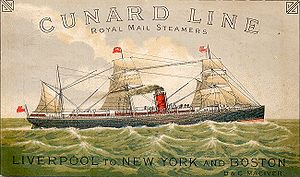SS Bothnia
 Poster image of SS Bothnia
| |
| History | |
|---|---|
| Name | SS Bothnia |
| Namesake | Bothnia |
| Owner | Cunard Line |
| Port of registry | Liverpool |
| Builder | J. & G. Thomson & Co., Clydebank |
| Yard number | 128 |
| Launched | 4 March 1874 |
| Completed | June 1874 |
| Maiden voyage | 8 August 1874 |
| Identification |
|
| Fate | Scrapped, 1899 |
| General characteristics | |
| Type | Steamship |
| Tonnage | |
| Length | 422 ft 2 in (128.68 m) |
| Beam | 42 ft 2 in (12.85 m) |
| Depth | 18 ft 11 in (5.77 m) |
| Propulsion | 1 × 600 hp (447 kW) steam compound steam engine |
| Sail plan | Barque-rigged |
| Speed | 12.5 knots (23.2 km/h; 14.4 mph) |
| Capacity |
|
SS Bothnia was a British steam passenger ship that sailed on the trans-Atlantic route between Liverpool and New York City or Boston. The ship was built by J & G Thomson of Clydebank, and launched on 4 March 1874 for the British & North American Royal Mail Steam Packet Company, which became the Cunard Line in 1879.[1]
Constructed with an iron hull ship, and 4,535 gross register tons, and with a length of 422 feet. She was powered by a 600 hp 2-cylinder compound steam engine, barque-rigged on three masts, and had a top speed of 121⁄2 knots. She could carry up to 1,400 passengers, 300 in first class and 1,100 in 3rd class.[1]
Bothnia sailed on her maiden voyage from Liverpool to New York via Queenstown on 8 August 1874, and on 15 April 1885, made her first voyage from Liverpool to Boston. She was withdrawn from service in mid-1898 and then sold, and was scrapped in Marseille in 1899.[2]
References
[edit]- ^ a b "SS Bothnia". Clyde-built Ship Database. 2012. Archived from the original on 7 November 2004. Retrieved 3 November 2012.
{{cite web}}: CS1 maint: unfit URL (link) - ^ "Bothnia, Cunard Line". norwayheritage.com. 2012. Retrieved 3 November 2012.
